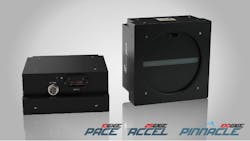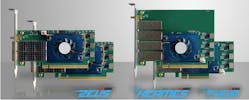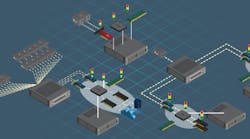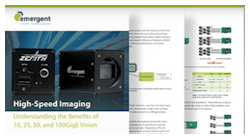While perhaps a somewhat niche application in the overall machine vision world, line scan cameras continue to add tremendous value in applications where materials moving at high speed must be inspected for quality assurance. Like all other machine vision applications and technologies that have advanced as manufacturing processes evolve, line scan imaging has seen significant developments in recent years, including the release of 10GigE, 25GigE, and now 100GigE line scan cameras.
High-Speed Interface Developments
During operation, an object or part being inspected moves in front of or beneath the image sensor, which captures the entire surface, one pixel row at a time; then, the line scan camera builds these rows into a single image. Line scan cameras, often deployed to inspect for damage or cracks, can be used on flat surfaces, round or cylindrical parts, and objects in continuous motion, such as a web. In such applications, a single line scan camera can handle a task that may involve multiple area scan cameras to cover the same surface.
Advancements in line scan camera capabilities — such as speed — have been driven by the availability of innovative CMOS image sensors, which are in turn driven by high-speed application requirements. While many applications today require higher speeds and higher resolutions, without the proper interfaces line rates may not meet these requirements. Line scan camera manufacturers such as Emergent Vision Technologies have responded to these growing demands by introducing innovative new offerings — including 10GigE, 25GigE, and 100GigE line scan cameras — designed for today’s machine vision and imaging challenges.
100GigE Opens New Doors in Machine Vision
Emergent Vision Technologies has introduced two 100GigE line scan camera models, the LZ-16KG5 and the TLZ-9KG5. Based on the 16Kx16 pixel Gpixel GL5016 CMOS sensor, the LZ-16KG5 is available in monochrome and color versions. Through its 100GigE QSFP28 interface, the camera achieves a single line rate of 400KHz and a trilinear rate of 133KHz, delivering unprecedented speeds for today’s challenging machine vision applications where line scan techniques are applicable. Additional features include an 81.92 mm sensor scanning width, standard M86 mount, 1 μs–1 s exposure/integration time, 66 dB dynamic range, flat shading and spatial corrections, and Windows and Linux O/S compatibility.
Based on Gpixel’s 9K 256 TDI GLT5009BSI CMOS image sensor, the TLZ-9KG6 time delay integration (TDI) line scan camera offers single line speeds of up to 608KHz at 9K resolution. The camera leverages the TDI imaging method, which delivers increased sensitivity by oversampling a scene across multiple line sensors that are synchronized in a time-delayed method with the relative motion between the scene and line sensors. TDI imaging techniques combine the charges from multiple line sensors, which allows the signal-to-noise ratio to increase, resulting in images with sufficient contrast at ultra-high speeds. Additional features include a 36 mm sensor scanning width, an M52 mount, 1 μs–1 s exposure/integration time, 66 dB dynamic range, flat shading and spatial corrections, and Windows and Linux O/S compatibility.
Both models offer GigE Vision and GenICam compliancy and allow cable lengths from 1 M up to 10 KM without requiring costly fiber converters/repeaters. The nearest competing solutions to these 100GigE line scan cameras require the use of multiple frame grabbers with the camera, compared to the single 100GigE network interface card (NIC) Emergent offers. In fact, Emergent dual port 100GigE NICs can support two 100GigE cameras on the same card.
A Range of Speed and Resolution Options
In addition to 100GigE line scan cameras, Emergent also makes several 25GigE and 10GigE models. In the Accel 25GigE series, models are available in both monochrome and color, and feature 8Kx4, 8Kx16, 9K 256 TDI, 16Kx2, and 16Kx16 CMOS image sensors from Gpixel. In this series, cameras can reach single line rates up to 300KHz and trilinear line rates of 100KHz.
For 10GigE models, the Pace LR series (10GigE SFP+) features both monochrome and color options with 4Kx2, 8Kx4, 8Kx16, 9K 256 TDI, 16Kx2, and 16Kx16 CMOS image sensors from Gpixel. These cameras can reach 172KHz in single line mode and up to 57KHz in trilinear mode. Featuring a 10GigE RJ45 interface, the Pace LT camera series offers the LT-8KG model, which is available with monochrome or color versions of the Gpixel GL0816 CMOS image sensor. This camera reaches 137KHz in single line mode and 45KHz in trilinear.
While not every machine vision application requires line scan imaging techniques — or even cameras that reach such speeds — these 10GigE, 25GigE, and 100GigE cameras provide systems integrators and OEMs viable options for handling challenging applications when necessary. For questions or inquiries on Emergent Vision Technologies’ line scan cameras, reach out today.






![Exo Svs Vistek Pipettenprüfung[1] Exo Svs Vistek Pipettenprüfung[1]](https://img.vision-systems.com/files/base/ebm/vsd/image/2023/05/EXO_SVS_Vistek_Pipettenpru__fung_1_.645d3640bd697.png?auto=format,compress&fit=crop&q=45&h=139&height=139&w=250&width=250)
